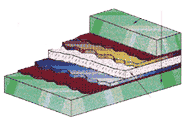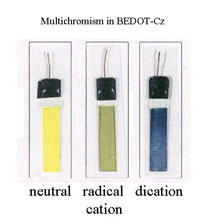 John Reynolds
John Reynolds (352) 392-9151
reynolds@chem.ufl.edu
Ph.D., University of Massachusets, 1985
 Organic
polymers can be made with a broad range of useful electrical and optical
properties. In our research we investigate how the molecular and supramolecular
structure affects these properties and use that knowledge to design and
synthesize polymers. We seek polymers with high electronic and ionic
conductivities, along with redox active electrochromism and biomolecule release.
We also study transition metal complex-containing polymers that act as infrared
radiation filters and sensors, along with conjugated polymers that are water
soluble and can be utilized in a number of electronic and optical devices.
Organic
polymers can be made with a broad range of useful electrical and optical
properties. In our research we investigate how the molecular and supramolecular
structure affects these properties and use that knowledge to design and
synthesize polymers. We seek polymers with high electronic and ionic
conductivities, along with redox active electrochromism and biomolecule release.
We also study transition metal complex-containing polymers that act as infrared
radiation filters and sensors, along with conjugated polymers that are water
soluble and can be utilized in a number of electronic and optical devices.
 Various
transition metal mediated coupling polymerization methodologies are used to
prepare p-phenylene and heterocycle-containing conjugated polymers. Recently, we
have succeeded in preparing electroluminescent polymers that can be processed
from environmentally useful aqueous solutions. By directly appending this
bis-salicylidene metal complexes to the backbones of polythiophenes,
electroactive polymers with redox chemistry sensitive to electron-donating
species in solution have been prepared and can be considered as new sensor
materials.
Various
transition metal mediated coupling polymerization methodologies are used to
prepare p-phenylene and heterocycle-containing conjugated polymers. Recently, we
have succeeded in preparing electroluminescent polymers that can be processed
from environmentally useful aqueous solutions. By directly appending this
bis-salicylidene metal complexes to the backbones of polythiophenes,
electroactive polymers with redox chemistry sensitive to electron-donating
species in solution have been prepared and can be considered as new sensor
materials.
Electrochromic polymers, which can be either anodically or cathodically coloring, and exhibit colors over the entire visible spectrum are under study. Utilizing oxidatively polymerizable 3,4-alkylenedioxythiophene based monomers (our XDOT monomers) we are able to tailor both optical and electrochemical properties. These polymers exhibit extremely rapid switching rates and electrochromic contrasts necessary for switchable window and display applications.
For more information on Dr. Reynold's research,
visit his lab's webpage